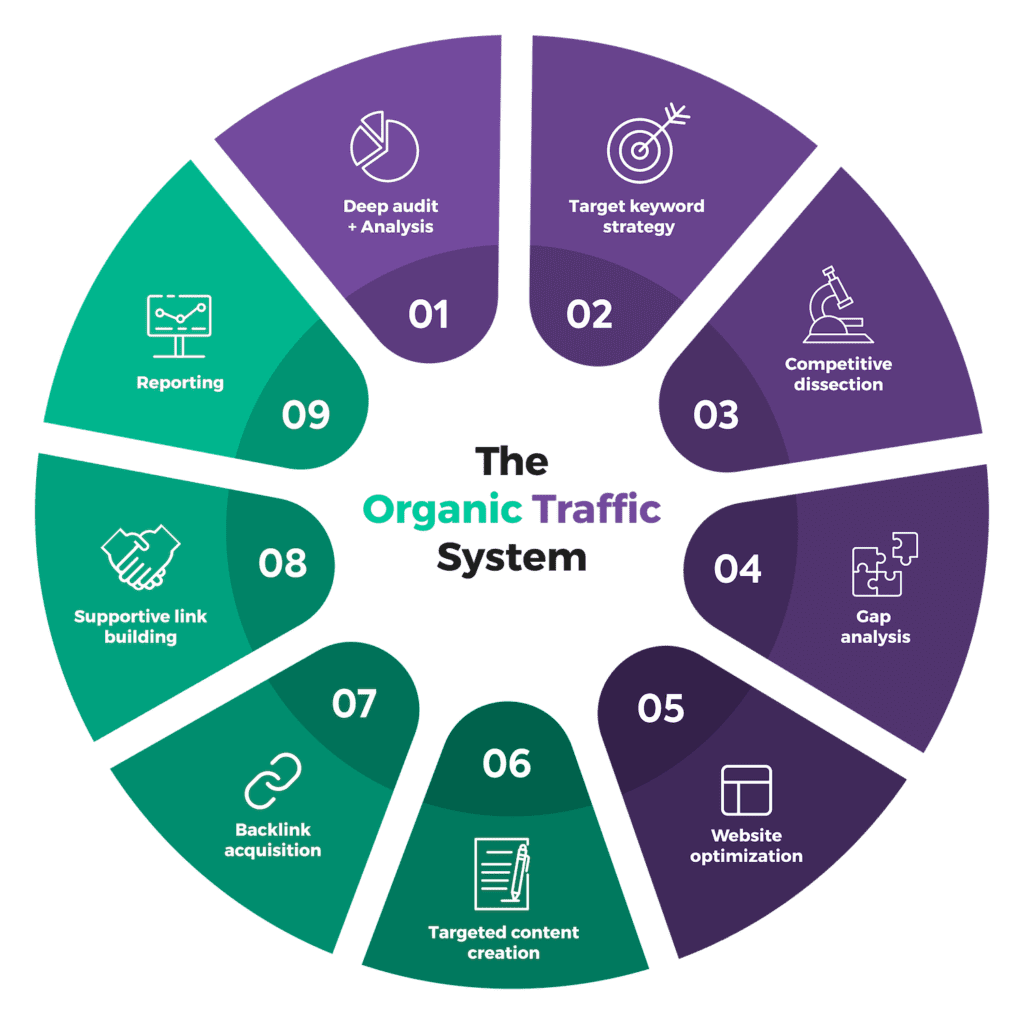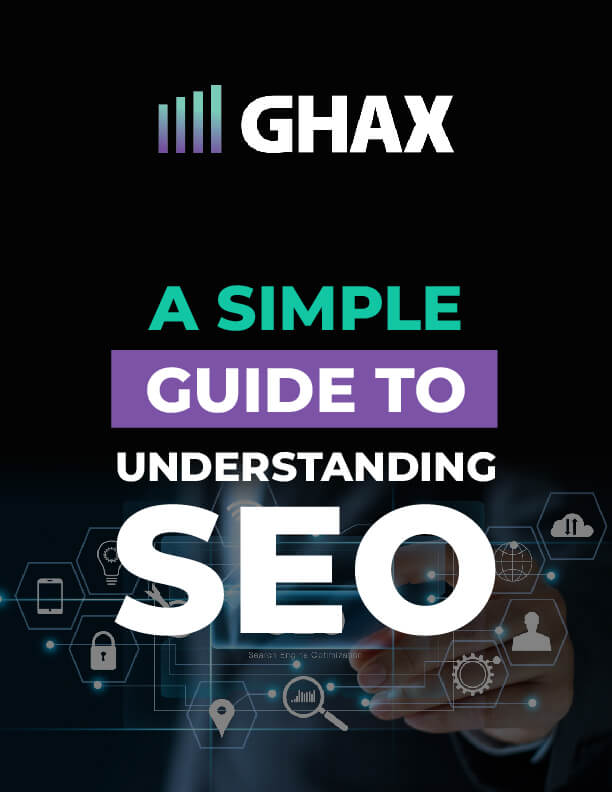You’ve probably heard and know that ranking at the top of Page 1 of Google can 10X the lead flow to your business and allow you to be worry-free about where new business will be coming from.
But nobody actually shows you how to do this yourself.
Instead, you’re told to “create content” or to just go spend money on ads to achieve ranking, when the reality is that you can achieve top-ranking Google positions completely organically by following a process.
That’s why in this video I’m going to show you exactly how to achieve Page 1 Google rankings in 2024 so that you can increase your organic search traffic, improve the quality and quantity of your leads, and establish your business as the number 1 authority in your industry.
The Organic Traffic System
Let’s walk through what I call the Organic Traffic System, which consists of nine phases and is going to set the foundation for your strategy for the next 3–6 months.

This system is the exact process we follow to achieve growth like this

Like this

And like this

Let’s get to it.
Phase 1: Deep Audit + Analysis
Start by conducting an in-depth analysis of your website and identify any hidden technical issues and opportunities for improvement.
I recommend using tools such as Ahrefs and SEMrush to do the analysis of your site, as within these tools, you can use functions such as site auditing to understand any deep-rooted issues that your site may have.
It might look something like this audit that we ran for a client (share screenshot)…
You’ll want to look for issues with performance, HTML tags, content quality, and incoming and outgoing links—most of which you’ll need to address—as these can all have damaging effects on your site’s ability to rank.
Phase 2: Target Keyword Strategy
This is where you want to pinpoint the most valuable keywords for your niche, focusing on keywords with high search volumes and low competition.
This is referred to as the “Easy Wins” approach.
You can use a tool like Ahrefs to research keywords and view their estimated search volume as well as the difficulty level for ranking. Keep in mind that longer-tail (or more specific) keywords are easier to rank for than more generic keywords.
For example, let’s say you sell running shoes and you sell a pair that are red and have velcro straps. Ranking for red running shoes with velcro straps is going to be easier than just the key term running shoes.
Not only that, you end up driving more targeted traffic when you focus on those long-tail keywords, as the searcher’s intent is high.
Phase 3: Competitive Dissection
This is where you drop your competitor’s URL into whatever tool you’re using, and you analyze what keywords they rank for, what position they rank for, how many banklinks they have, and what their traffic trend looks like.
In this stage, it’s also useful to search for the long-tail keywords that you want to rank for using Google search directly, identify who holds the top positions, and enter those specific URLs into tools like Ahrefs to dive deeper into why those might be the top-ranking pages for the search term you entered.
Phase 4: Gap Analysis
In this phase, you want to compare your current keyword rankings to those of your competitors, and work to identify content gaps and areas where you can seize market share. Meaning, which keywords do your competitors rank for but your site does not.
You can use something like Ahrefs’ Content Gap tool that allows you to do that with a bunch of competitors at the same time, giving you a massive list of keywords that you should be targeting.
Phase 5: Website Optimization
Optimize your website’s on-page elements, such as meta tags, headings, and internal link structure, to improve crawlability. Simple tools like Yoast SEO or RankMath SEO (assuming you have a WordPress site) can guide you through optimizing each page on your site. But be careful not to get too caught up in satisfying what the plugin is recommending. You really just want to use it as a guide.
And I hate to have to say this in 2024, but make sure that your website is mobile-friendly.
Phase 6: Targeted Content Creation
Remember back in Phase 2 when you did keyword research? You’re going to use that here to create content that addresses those keywords and topics. You can use AI tools like ChatGPT to create blog titles and outlines to give you a head start, simply by prompting ChatGPT to craft a blog title and outline that focuses on a specific keyword or topic.
Keep in mind that your content should provide value, answer questions, and solve problems for your audience.
Also, be sure to include both outbound links (which are links to external websites) as well as internal links (which are links to other relevant pages within your website) in your content.
Phase 7: Backlink Acquisition
This phase can be one of the more time-consuming elements of the strategy, as it requires research, outreach, and potentially more content creation. But it is one of the most important.
You can see in this chart where our client was penalized and lost a lot of traffic before bringing us in. We began building quality backlinks (along with content), and over the course of 6 months, we were able to recover their positions and put them back on the growth path instead of the cliff that they were falling off of.
Although there are many ways to approach acquiring backlinks, here are two methods:.
The first is guest posting. This is when you find a relevant blog within your industry, offer to write free content for their blog, and within that content, there is a link back to your website. You’re essentially exchanging the free content for a link.
The second method is simply emailing people that you mention in your content. Although it’s simple, it works well. Remember in the last phase when I said to include outbound links? That’s where this can come into play.
Let’s say you write a piece of content and link out to another website within your content. You can simply email the site that you linked out to, let them know that you mentioned them, and make the ask for a link back.
It doesn’t always work, but it is a simple approach that doesn’t require much more effort than sending an email.
Phase 8: Supportive Link Building
In this phase, you’ll seek to build links to the pages that link to your website. So essentially, you’re working to boost the authority of the website that is linking back to yours, which makes the original backlink you acquired more authoritative.
You can do this in a number of ways.
One way is by using social media. Although social media links are usually marked as nofollow by Google (meaning they won’t truly improve the page rank of the page they’re pointing to), Google still treats these links as positive.
But the best way, in my opinion, and most time-consuming, would be through additional guest posting, where, just like in the last step, you’re creating content in exchange for a link, but this time the link is going to the page linking to your site and not your site directly.
And lastly…
Phase 9: Reporting and Monitoring
You want to be sure to track and analyze your SEO efforts using Google Analytics, Google Search Console, and even a third party tool such as ahrefs or SEMrush. These tools help you monitor your keyword rankings, organic traffic, and overall website performance. Consistently reviewing these metrics allows you to adjust your strategy as needed, ensuring continuous improvement in your SEO campaign.
Wrapping Up
So that’s exactly how to climb the ranks of Google in 2024.
You now have everything you need to do this yourself: increase your organic traffic, the quality of your leads coming in, and become an authority in your niche, never having to worry about where your leads are coming from.
However, as with everything, there are going to be bottlenecks when you try and do this yourself that I couldn’t quite cover in this video.
Ranking high on Google for each business is a case-by-case basis, and the video would never have ended if I covered every single specific keyword strategy or competitive research process for every industry.
So while you have option 1 of taking this and trying to implement everything I covered for you in this video yourself, you do have a better option to achieve your results.
If you want me and my team to help you implement the organic traffic system into your business so you can rank your website on page 1 of Google for your targeted keywords, then click here.




